Organizations clinging to outdated data management methods are struggling to realize data’s potential and keep pace with the demands of a hyper-competitive digital world. The data-as-a-product approach revolutionizes traditional data management by grounding it in product management principles. Our step-by-step research can help IT and data leaders treat data as a product – with customer needs front and center – to optimize data management, enhance service to data customers, and align data initiatives with organizational goals.
As organizations face exponential data growth, traditional data management methods fall short, leading to poor data quality, slow data delivery, and missed opportunities. By treating data as a vital asset and adopting a product management approach that prioritizes the data customer, organizations can unlock the full potential of their data.
1. Transform your raw data into a meaningful product.
With an emphasis on customer-centric design and scalability, the data-as-a-product approach can transform data assets into strategic tools that drive innovation, improve decision-making, accelerate growth, and ultimately deliver value to data product customers. Examples of data products include chatbots, fraud detection systems, and analytics dashboards.
2. Data-as-a-product is not plug-and-play.
Organizations that lack strong data quality, effective data management, modern technology, and a data-driven culture may struggle with implementing the data-as-a-product approach. However, with a clear understanding of your data customers’ needs – along with a well-defined data opportunity and use case – organizations can take the first steps toward implementing this approach.
3. (Customer) knowledge is power.
When a data product fails, it is typically because the focus was on developing the solution first and then searching for problems that it can solve. Success comes from prioritizing a deep understanding of customer needs and then building data products that address those needs. Successful data product teams embrace a customer-first mindset.
Use our step-by-step research to help you drive value from your critical data assets
Implementing the data-as-a-product approach will optimize how data is managed across your organization to better serve your data customers. This research provides an overview, along with practical tools to help you launch your customer-centric data-as-a-product journey:
- Assess whether your organization is ready to adopt the data-as-product approach by evaluating key dimensions of readiness.
- Create personas to gain insights into your customers and their journey with the data product.
- Define the data opportunities and use cases, then prioritize the most impactful ones.
- Evaluate and prioritize the right use case for your pilot data product.
- Select your pilot data product and align on a shared vision.
Launch a Customer-Centric Data-as-a-Product Journey
Leverage data as a strategic asset to unlock its full potential.
Analyst perspective
Adopting the data-as-a-product approach helps your organization unlock the full potential of data.
Data is the backbone of all organizations.
Today, many organizations are experiencing exponential growth of data. As the volume of data grows, managing and scaling it across the enterprise becomes increasingly complex, making it a top challenge and priority for data and IT leaders.
Traditional methods of data management are often ill-suited to handling increasingly large volumes of data, often resulting in poor data quality, slow data delivery, and missed opportunities. For years, IT has collected data without direction, then asked the business what to analyze. Now, with the data-as-a-product approach, IT works with the business to focus on value-driven analysis from the start.
Data-as-a-product flips the script on the traditional methods of managing data. With this new method, grounded in the principles of product management, data leaders shift their perspective from viewing data as numbers to recognizing data as a strategic asset.
Creating data alignment, promoting data literacy, gaining stakeholder buy-in, and establishing data governance can help an organization reach its goals as well as build a data culture focused on continuous improvement and value delivery. One method to achieve these outcomes is by treating data as a product.
This research provides an overview of data-as-a-product, along with practical tools to help you understand your data product customers, identify data opportunities, evaluate and prioritize a use case, pick your pilot data product, and (optional) articulate a vision for your data product.

Pooja Khandelwal
Senior Research Analyst
Info-Tech Research Group
Executive summary
| Your Challenge | Common Obstacles | Info-Tech's Approach |
|
Your organization is inundated with more and more data every day. You are experiencing several challenges:
|
|
|
Info-Tech Insight
Data is not just numbers. Treating data as an asset and adopting a product management mindset can transform data's use across the organization, enhance its value by aligning with organizational goals, and help mitigate potential risks.
Insight summary
Overarching insight
Data is not just numbers. Treating data as an asset and adopting a product management mindset can transform data's use across the organization, enhance its value by aligning with organizational goals, and help mitigate potential risks.
Amplify your data by treating it as a strategic asset that delivers value.
Treating data as a product transforms data into assets that can be used as strategic tools to drive innovation, improve decision-making, accelerate growth, and ultimately deliver value to the data product customers.
Building trust around data is essential.
Establishing a robust and comprehensive governance plan for data-as-a-product will create accountability, improve data literacy and usability, foster trust, and impact data product accessibility while ensuring optimal data product quality.
Data products are an evolution, not a revolution.
Data products are an evolution of existing methodologies, not a radical shift. By applying proven patterns from data science and product management, they adapt best practices to create value from data, ensuring effective development and management.
Securing leadership support is the key to investing in data-as-a-product.
To fully invest in data-as-a-product, data leaders must gain early stakeholder support, boost data literacy, and foster a strong data culture. This approach unlocks the full potential of data, leading to improved decision-making, increased efficiency, and greater value from data products - resulting in proven ROI.
Info-Tech's methodology for launching a customer-centric data-as-a-product journey
| Launch a Customer-Centric Data-as-a-Product Journey | |
| Steps |
1.1 Complete the readiness assessment. 1.2 Identify your persona and create a persona journey map. 1.3 Discover data opportunities and use cases, then prioritize the most impactful ones. 1.4 Select your pilot data product and (optional) define the vision for your data product. |
| Outcomes |
|
Blueprint deliverables
Each step of Launch a Customer-Centric Data-as-a-Product Journey is accompanied by supporting tools to help you accomplish your goals.
Data-as-a-Product Readiness Assessment
Assess whether your organization is ready to adopt the data-as-a-product approach by completing a questionnaire that evaluates key dimensions of readiness.
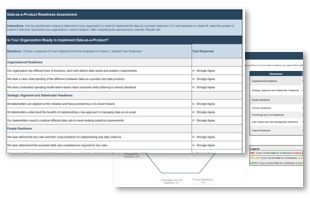
Data-as-a-Product Activities Workbook
This supporting workbook captures interim results from the various exercises that contribute to building your alignment presentation.
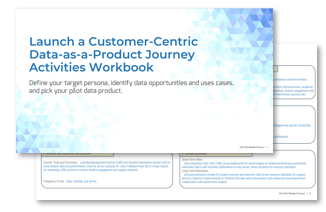
Key Deliverable:
Data-as-a-Product Alignment Presentation Template
Create alignment on the data-as-a-product approach and identify the impacts and benefits of adopting it.

Info-Tech offers various levels of support to best suit your needs
| DIY Toolkit | Guided Implementation | Workshop | Executive & Technical Counseling | Consulting |
|---|---|---|---|---|
| "Our team has already made this critical project a priority, and we have the time and capability, but some guidance along the way would be helpful." | "Our team knows that we need to fix a process, but we need assistance to determine where to focus. Some check-ins along the way would help keep us on track." | "We need to hit the ground running and get this project kicked off immediately. Our team has the ability to take this over once we get a framework and strategy in place." | "Our team and processes are maturing; however, to expedite the journey we'll need a seasoned practitioner to coach and validate approaches, deliverables, and opportunities." | "Our team does not have the time or the knowledge to take this project on. We need assistance through the entirety of this project." |
Diagnostics and consistent frameworks are used throughout all five options.
Phase 1
Launch a Customer-Centric Data-as-a-Product Journey
1.1 Evaluate the organization's readiness
1.2 Create a persona and journey map
1.3 Identify data opportunities and prioritize use cases
1.4 Pick your pilot data product and (optional) define the vision for your data product
This phase will walk you through the following activities:
- Complete a questionnaire to help you assess areas of readiness and identify gaps to address before adopting the data-as-a-product approach.
- Gain insights into your target data customer (persona) and understand their journey with the data product.
- Identify data opportunities, evaluate relevant use cases, and prioritize the right use case for your data product.
- Select your pilot data product and, optionally, align on a vision for it.
This phase involves the following participants:
- Chief Data Officer (CDO)
- Chief Product Officer (CPO)
- Data Team Lead
- Data Product Manager
What is data-as-a-product?
- Data-as-a-product is a holistic approach to harness the full potential of data assets.
- It unlocks value by transforming raw data into structured, accessible, and meaningful products, with a single point of accountability ensuring that the entire process - from data collection to delivery - meets quality standards and organizational objectives.
- This systematic approach to data management emphasizes accessibility, governance, and utility.
- Data-as-a-product streamlines data sharing and automates the delivery of data products, breaking down silos by connecting disparate sources. It simplifies the onboarding of reusable data products, enabling the same data to be used with different metadata tailored to specific use cases, regardless of where the data resides.
- Successful implementation of a data-as-a-product approach must be:
- Easily discoverable
- Addressable
- Trustworthy
- Well-documented
- Complements other data products
- Secure
- Leverage the data-as-a-product approach to build, manage, and optimize data products.
"Data as a product (DaaP) is an approach in data management and analytics where data sets are treated as standalone products designed, built and maintained with end users in mind. This concept involves applying product management principles to the lifecycle of data, emphasizing quality, usability and user satisfaction."
Source: "What is DaaP?" IBM, 2024
What are data products?
- Data products leverage data to deliver actionable insights and solutions, such as analytics dashboards and predictive models.
- They address specific opportunities, are supported by sophisticated data processing techniques, and cater to a broad audience, including product managers, data scientists, and customers.
- Data products can be built for internal or external customers at various levels of maturity.
- Examples of data products include:
- Analytics dashboard
- Chatbot
- Fraud detection system
- Sentiment analysis tool
- Data mart
- Data products are managed, structured, and delivered with a focus on quality, usability, and customer needs, like physical products.
- Data products can be integrated into other products. For example, a predictive analytics tool might be embedded into a CRM system, providing an organization with real-time insights to drive decision-making and improve engagement.
A data product is "a product that facilitates an end goal through the use of data."
Source: DJ Patil, Former US Chief Data Scientist, as quoted in Ascend.io, 2023.
Types of data products
Data infrastructure products are about governing and managing data at an organizational level.
Data domain products are about delivering usable data that is specific to a particular organizational function or domain.
Data Infrastructure Products
These data products focus on creating the foundational layers that ensure the data is accurate, accessible, and consistent.
Data infrastructure products are produced (they enable the management and flow of data).
Examples
- Master Data Product: Curated data sets that include reference data (such as customer, product, patient, or student information) that are quality-checked, quality-fixed, and enriched with precomputed totals and additional attributes. These data sets are designed to provide consistent, accurate, and comprehensive data for critical organizational processes.
- Reference Data Product: A standardized data set that is reused across the enterprise, typically consisting of public or foundational data used for consistent reference and integration across organizational systems and processes.
- Curated Data Product: Data that has undergone thorough quality checks and fixes, ensuring its accuracy and reliability. It is designed to be reusable across various organizational use cases.
- Augmented Data Product: A data set that includes precomputed totals (e.g. by week, functional unit, or geography) and additional attributes, typically derived from master data, to support a wide range of use cases across the organization.
Data Domain Products
These data products focus on integration and usability.
Data domain products are consumed (they deliver value to data customers).
Examples
- Customer Analytics Platform: Visualizes data from various touchpoints, such as websites or social media, to provide insights into customer behavior, preferences, and interactions.
- Financial Reporting Tool: Aggregates financial data for reporting, forecasting, and analysis.
- Supply Chain Optimization System: Uses supply chain data to optimize operations, forecasting, and inventory management.
- AI/ML Products: Uses algorithms to analyze data, make predictions, and automate decisions.
A data product looks different to every customer
| Customer | Purpose | Interactions with data | Data-serving capabilities | Examples of data products |
| Business User (Power User & Casual User) |
|
|
|
|
| Data Analyst |
|
|
|
|
| Data Scientist |
|
|
|
|
Data product customers include:
- Business User
- Power User: Advanced, frequent user who engages deeply with the data product's full capabilities.
- Casual User: Basic, occasional user who consumes prebuilt reports or dashboards for high-level insights without deep interaction with the data.
- Data Analyst
- Data Scientist
Each of these customers interact with data products differently, depending on their role, their technical expertise, and the purpose of the data product in their workflow.
Visualize a data product through an analogy
A data product is like a cookie that's made from raw data, baked by the data product manager, and then enjoyed by the data product customer.
Data Product Manager
Creates, develops, and maintains the data product.
Data Product Customer
Uses the data product to gain insights and make decisions.
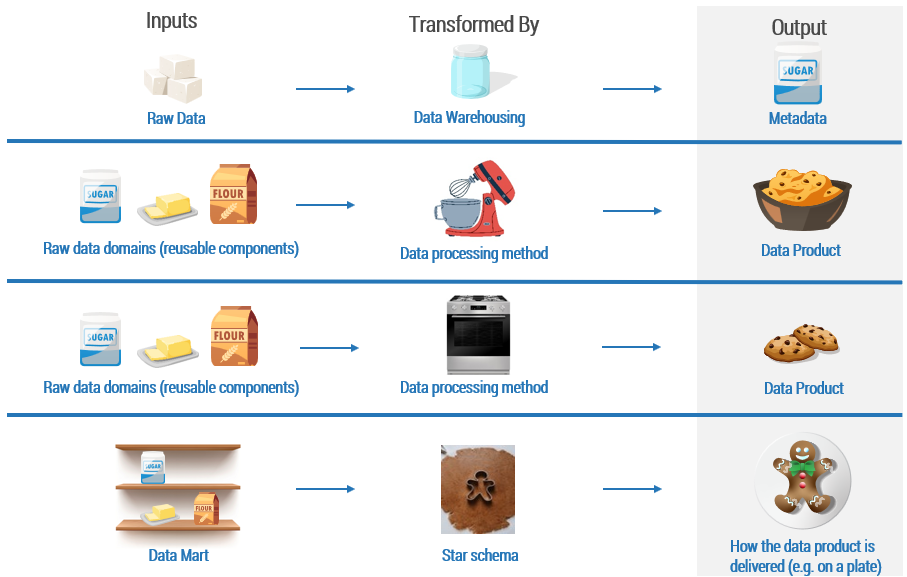
A data product is not an entirely new concept
Data marts have been around since the early 1970s, when companies like ACNielsen began offering "dimensional data marts" to enhance retail sales efforts. These early implementations were designed to provide decision support by focusing on specific organizational areas, laying the foundation for the modern use of data marts as subsets of data warehouses tailored to particular departments or functions.
| Category | Explanation |
|---|---|
| Data Mart Definition | A data mart is a specialized subset of a data warehouse that serves the analytical needs of a specific team or function within an organization. It acts as a focused repository of data, tailored to meet the requirements of particular departments or lines of business. |
| Data Mart Characteristics |
Specificity: Data marts contain curated data sets for specific departments, such as procurement, sales operations, or marketing. Size: They are smaller than data warehouses, typically containing data volumes around 100GB. Structure: Data marts often use star or snowflake schemas for efficient querying and analysis. |
| Connection to Data Products |
Data marts play a crucial role in the development and use of data products: Source for Analytics: Data marts provide preprocessed, relevant data that can be easily accessed by analysts for creating reports, dashboards, and other data products. Semantic Layer: They often include an autogenerated semantic model that serves as a simpler foundation, making reports and dashboards more easily understood by customers. SQL Access: Data marts offer SQL endpoints, allowing various tools and services to connect and use the data for creating advanced analytics products. |
The data-as-a-product approach goes beyond traditional data marts, which are often insufficient for enabling effective, scalable, and customer-centric data solutions. While data marts can become siloed, static, and fragmented, the data-as-a-product approach emphasizes customer-centric design, scalability, and strong governance. It fosters a more agile, integrated, and collaborative data ecosystem - one that is aligned with evolving customer needs and capable of adapting to changing requirements. This approach addresses the limitations of data marts and empowers organizations to leverage data more effectively at scale.
Source: Dataversity, 2012
How implementing the data-as-a-product approach will change how you work
Making the leap to data-as-a-product is a foundational shift that means moving from viewing data as a static asset to seeing it as a dynamic, composite product that is packaged to meet customer needs.
| Category | Traditional View | Data-as-a-Product View |
|---|---|---|
| Ownership and Accountability | Data ownership is often fragmented across various departments, with unclear accountability for data quality and accessibility. | A data product manager is accountable for streamlining data quality, accessibility, and usefulness. |
| Customer-Centric Design | Data is typically managed and stored without focusing on customer needs. | Data products are designed with the customer in mind, focusing on the right use case that addresses customer needs and priorities. |
| Data Quality and Usability | Data quality issues are common, with inconsistent formats, lack of validation, and limited usability for nontechnical data customers. | Data products emphasize quality and usability by ensuring that data is not only accurate and reliable but also structured in a way that is easily accessible and actionable for data customers. |
| Vertical Collaboration (between the organization, data teams, and product managers) |
Collaboration is siloed, with limited communication between departments, making it difficult to align data with organizational objectives. | Collaboration is central, ensuring alignment between the organization, data teams, and product managers. |
| End-to-End Lifecycle Management | Data is often managed in isolated stages, with limited oversight or integration across its full lifecycle, from collection to consumption. | Data products follow a lifecycle, from development to maintenance, with regular feedback and improvement. |
| Metrics and Success Measurement | Success is typically measured in disjointed metrics without a holistic view of how data contributes to organizational outcomes. | Success is defined by metrics that matter to data customers, such as adoption, satisfaction, and the impact of the data on the organization's outcomes. |
| Governance Framework | Governance has inconsistent policies and standards, lacking a clear, centralized framework for data stewardship. | Governance frameworks are flexible, with iterative improvements based on feedback from data product customers. |
Understand the downstream impacts of the data-as-a-product approach and data products
Impacts of the data-as-a-product approach:
Short-term impacts
- Gain stakeholder buy-in and alignment.
- Establish data governance.
- Improve data quality.
Long-term impacts
- Shifts your mindset toward a data-driven culture.
- Data becomes a key driver of strategic decisions, transforming processes and outcomes.
- Promotes continuous evaluation of data relevance and evolving semantics, adapting to changing organizational needs and production processes.
- Results in continuous improvement and delivery.
- Enables real-time data-driven decision- making.
- Establishes clear ownership and responsibility for the entire lifecycle and alignment with the data governance framework.
Impacts of data products:
Short-term impacts
- The organization can make better decisions, faster.
- Data becomes more accessible.
- There is clear ownership and accountability for data.
- Everyone has one source of truth and everyone is on the same page.
Long-term impacts
- Data products can scale with evolving needs.
- Data becomes a key driver of strategic decisions, transforming processes and outcomes.
- Incorporates feedback from customers on how the data products are performing, ensuring a dynamic, responsive approach to data product management.
- Results in continuous improvement and delivery.
- Makes IT's job easier because data is reused and data products are built for more than one customer segment.
Treating data as a product is a mindset change. Shifting your mindset will shift your data culture.
Your data product definition should include everything required to support it, not just what customers see
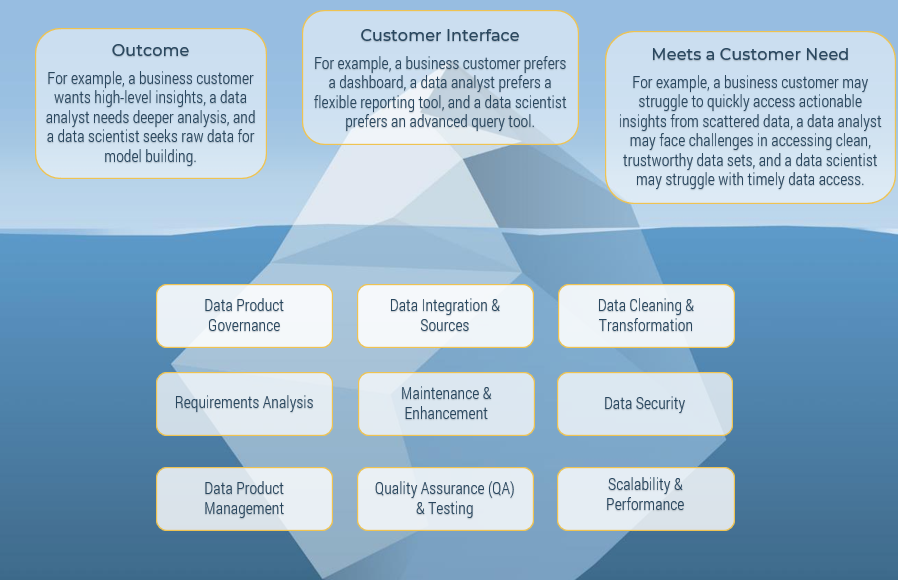
Info-Tech Insight
A great customer interface isn't enough to ensure success, just as the "below the water" work isn't sufficient on its own. You need both: a strong foundation and a customer-centric design. Success comes from aligning the unseen work with customers' needs to create a cohesive, effective data product.
Data products and services share the same foundation and best practices
"Data product"/"data service" and "data product owner"/"data service owner" are often used interchangeably. In this research, we use "data product" for consistency, but the analysis applies to data services as well.
"Data product" and "data service" are terms that each organization needs to define based on how they are delivered or consumed as well as the needs of internal and external customers. The most important aspect is consistent use and understanding of:
- External products
- Internal products
- External services
- Internal services
- Products as a service (PaaS)
- Productized services (SaaS)
How do we know what is a data product?
You have a data product if the given item:
- Product features
- Transactions
- Onetime solutions
- Nonrepeatable processes
- Solutions that have no customers
- People or teams
What isn't a data product:
- Has thorough metadata description of its origin and applied transformations.
- Has an interface to visualize or access data.
- Has some repository (i.e. it includes a structured way to store and manage data).
- Has customers or consumers.
- Delivers quantifiable value.
- Evolves or changes over time.
- Has predictable delivery.
- Has definable boundaries.
- Has a cost to produce and operate.
- Has data transparency and explainability.
Organizations are drowning in data and struggle with data alignment
The volume of data is skyrocketing
- In 2024, the global volume of data created, captured, copied, and consumed reached 149 zettabytes.1
- The global volume of data is projected to grow to more than 180 zettabytes by the end of 2025.1
Top Barriers to Data Management Goals2
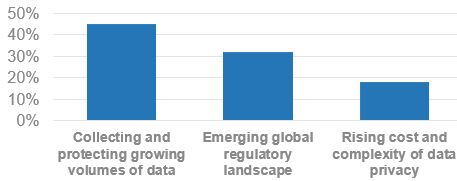
A study by Deloitte reveals that IT leaders face significant challenges in collecting and safeguarding growing volumes of data.
"At least 50% of our members struggle to align their data strategy with their organizational goals."
- Igor Ikonnikov, Advisory Fellow, Info-Tech Research Group
This misalignment often leads to data initiatives that don't support the organization's strategy, resulting in inefficiencies and missed opportunities.
Sources: 1 Statista, 2024; 2 Deloitte, 2022

 Establish an Analytics Operating Model
Establish an Analytics Operating Model
 Create and Manage Enterprise Data Models
Create and Manage Enterprise Data Models
 Build a Robust and Comprehensive Data Strategy
Build a Robust and Comprehensive Data Strategy
 Mandate Data Valuation Before It’s Mandated
Mandate Data Valuation Before It’s Mandated
 Position and Agree on ROI to Maximize the Impact of Data and Analytics
Position and Agree on ROI to Maximize the Impact of Data and Analytics
 Establish the Target Operating Model Needed to Execute Your Data Strategy
Establish the Target Operating Model Needed to Execute Your Data Strategy
 Establish Data Governance
Establish Data Governance
 Build a Data Architecture Roadmap
Build a Data Architecture Roadmap
 Build a Data Integration Strategy
Build a Data Integration Strategy
 Build a Data Pipeline for Reporting and Analytics
Build a Data Pipeline for Reporting and Analytics
 Build Your Data Quality Program
Build Your Data Quality Program
 Mitigate Machine Bias
Mitigate Machine Bias
 Design Data-as-a-Service
Design Data-as-a-Service
 Define the Components of Your AI Architecture
Define the Components of Your AI Architecture
 Get Started With Artificial Intelligence
Get Started With Artificial Intelligence
 Go the Extra Mile With Blockchain
Go the Extra Mile With Blockchain
 Understand the Data and Analytics Landscape
Understand the Data and Analytics Landscape
 Select Your Data Platform
Select Your Data Platform
 Build Your Data Practice and Platform
Build Your Data Practice and Platform
 Establish Data Governance – APAC Edition
Establish Data Governance – APAC Edition
 Foster Data-Driven Culture With Data Literacy
Foster Data-Driven Culture With Data Literacy
 Generative AI: Market Primer
Generative AI: Market Primer
 Establish Effective Data Stewardship
Establish Effective Data Stewardship
 Identify and Build the Data & Analytics Skills Your Organization Needs
Identify and Build the Data & Analytics Skills Your Organization Needs
 Promote Data Literacy in Your Organization
Promote Data Literacy in Your Organization
 Define a Data Practice Strategy to Power an Autonomous Enterprise
Define a Data Practice Strategy to Power an Autonomous Enterprise
 Data Culture Diagnostic
Data Culture Diagnostic
 Fueling AI Greatness: The Critical Role of Data & AI Literacy
Fueling AI Greatness: The Critical Role of Data & AI Literacy
 Building the Road to Governing Digital Intelligence
Building the Road to Governing Digital Intelligence
 Map Your Data Journey
Map Your Data Journey
 Launch a Customer-Centric Data-as-a-Product Journey
Launch a Customer-Centric Data-as-a-Product Journey